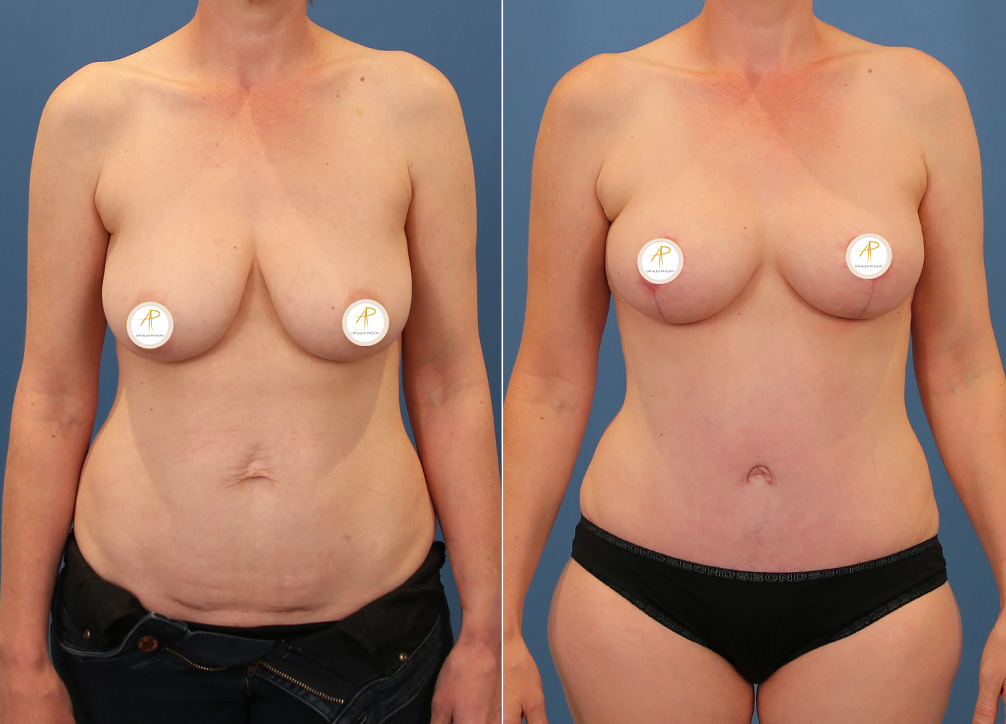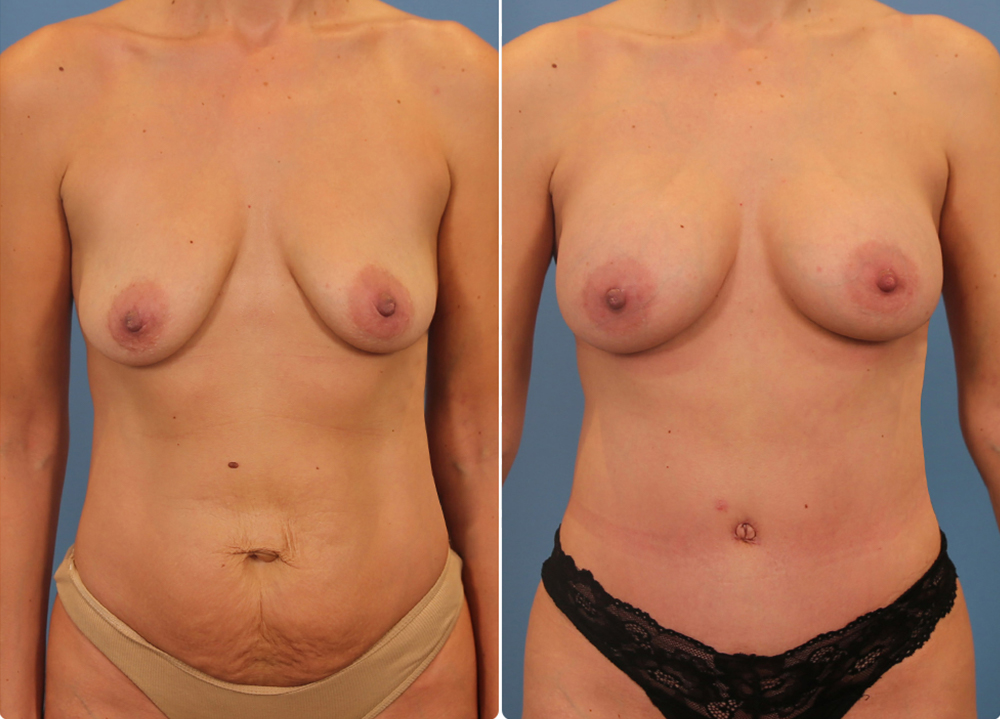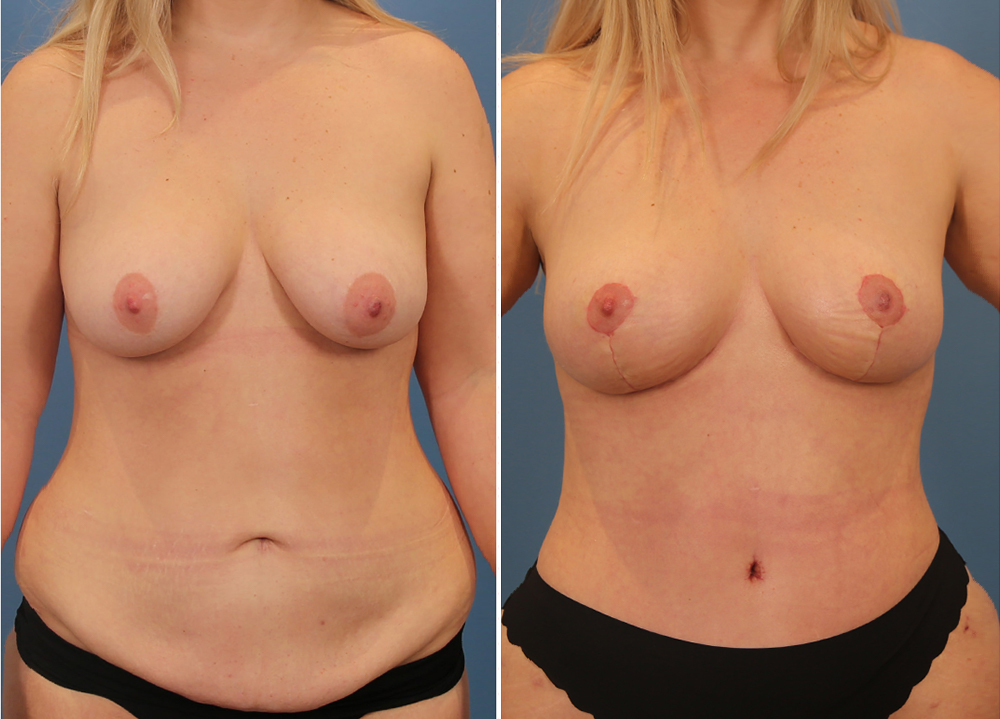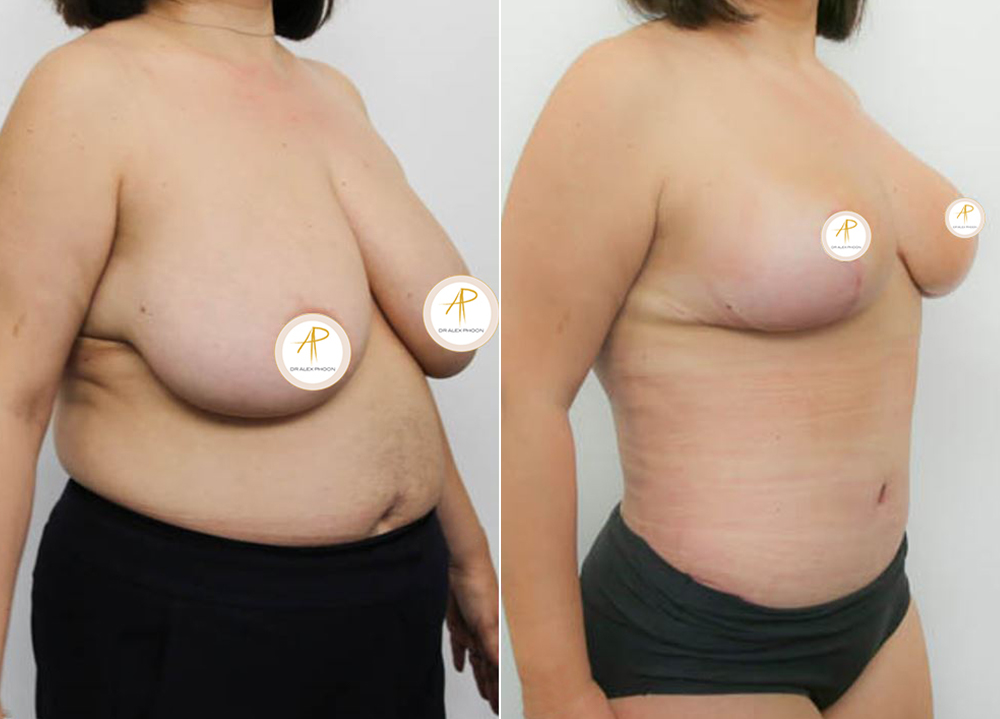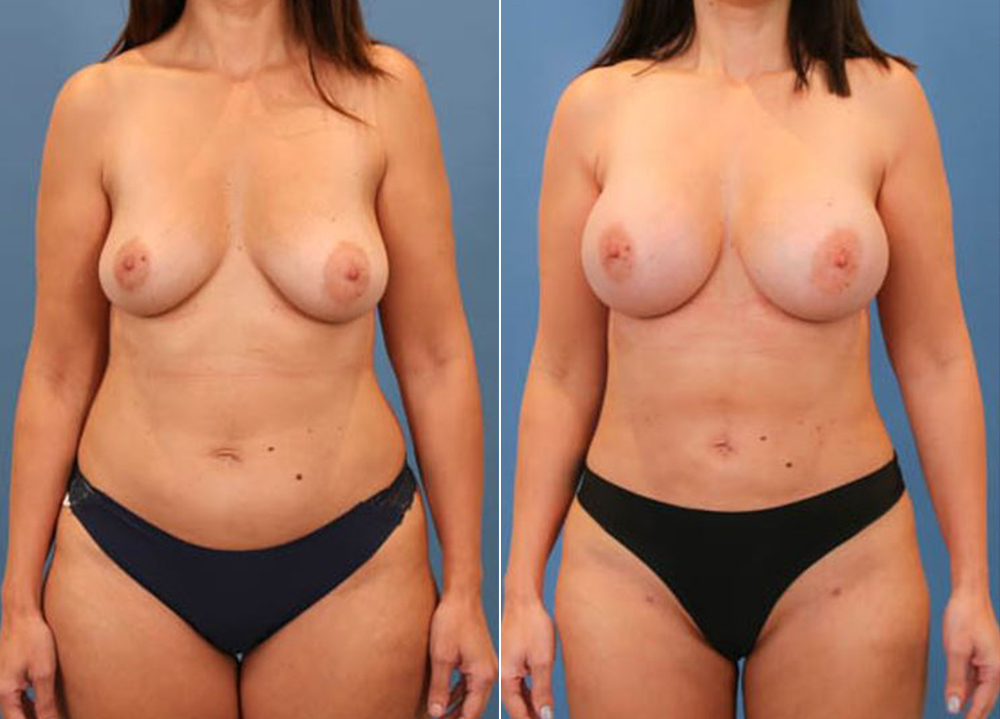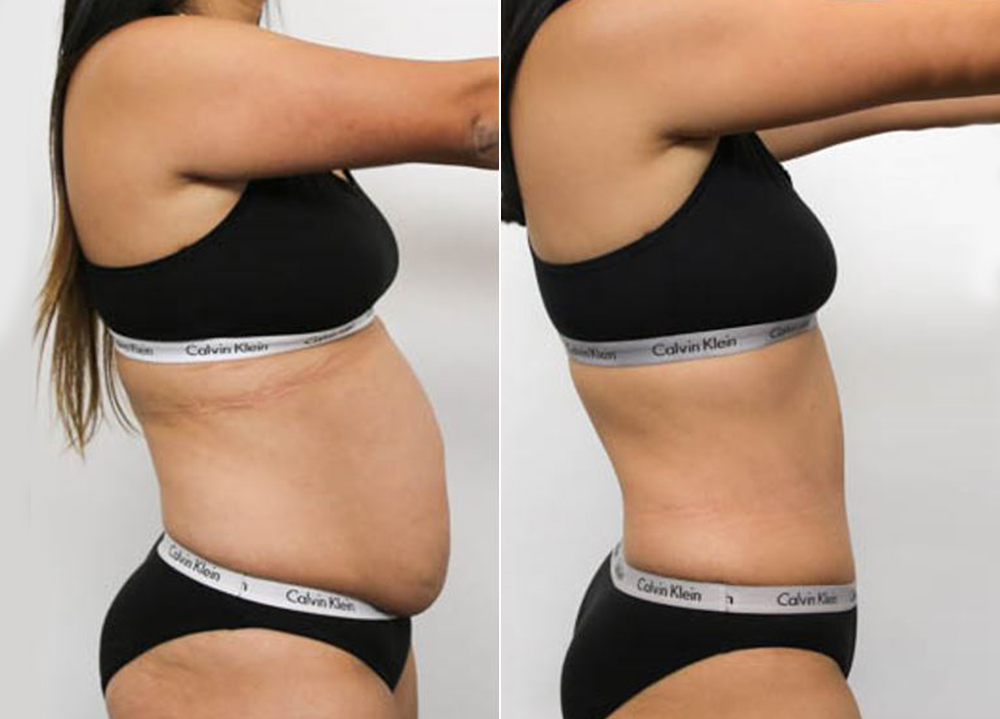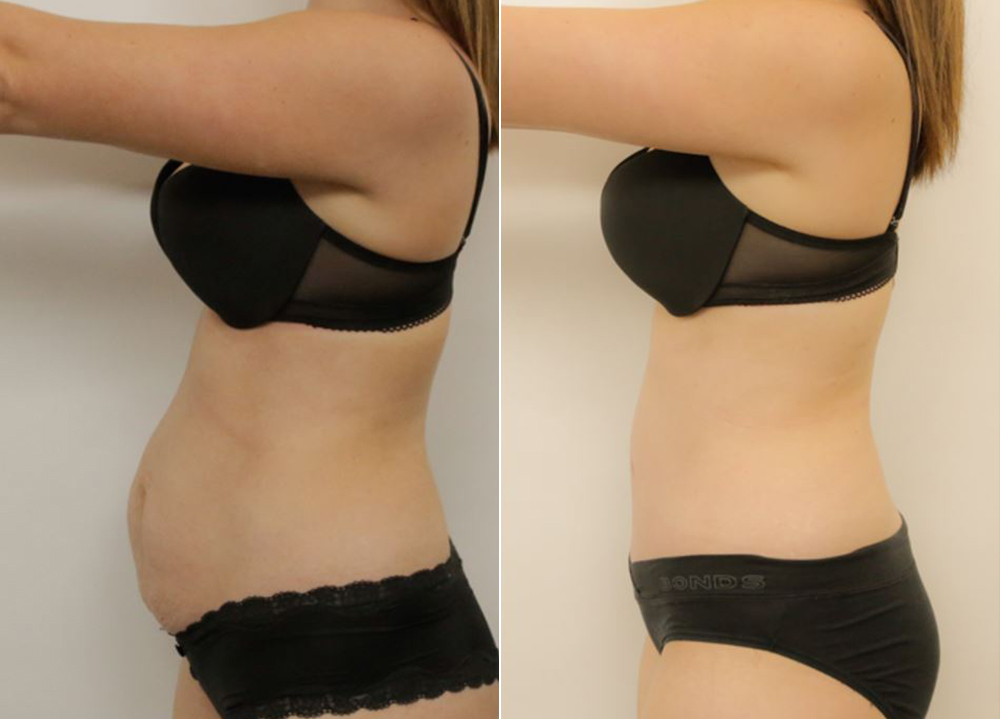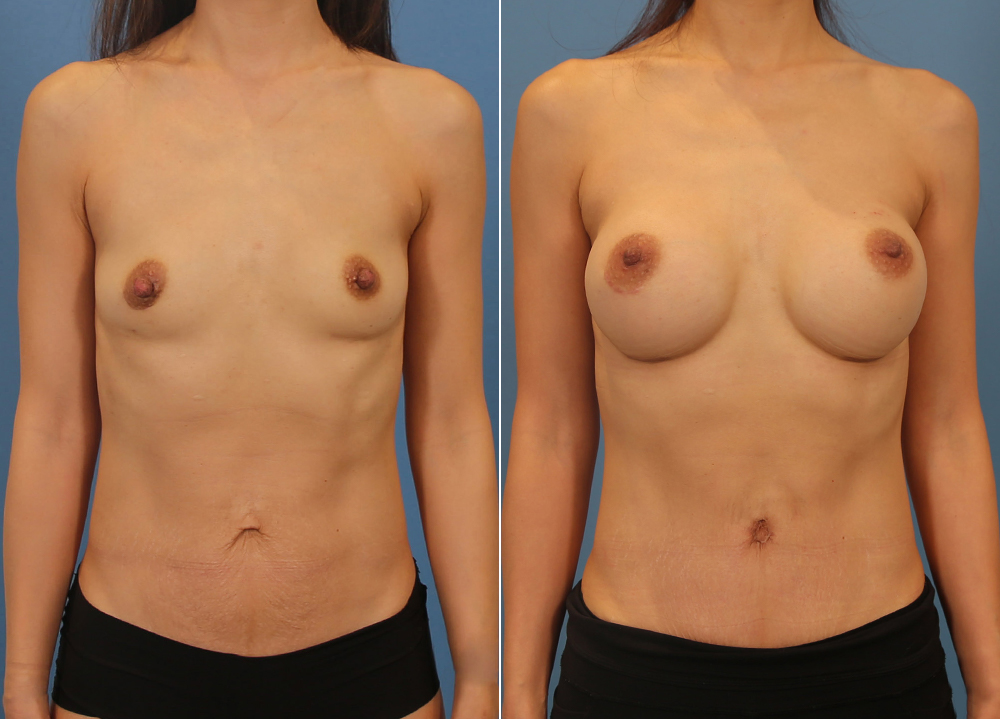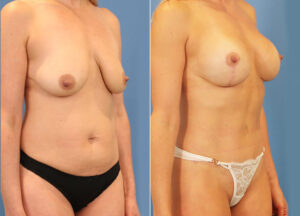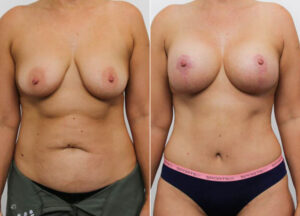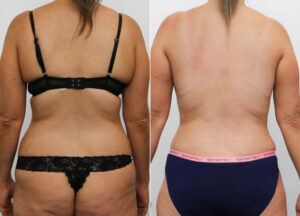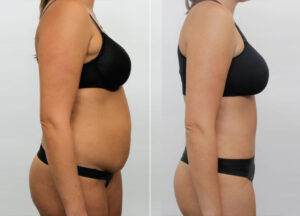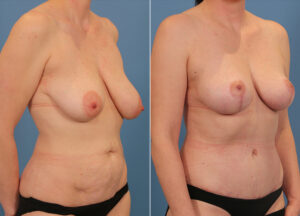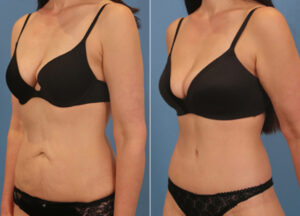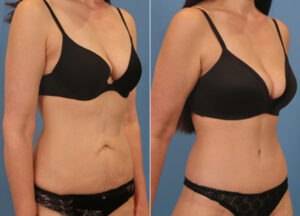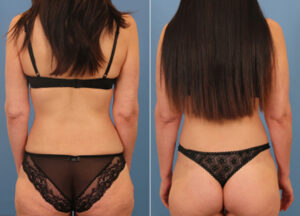WHAT IS POST-PREGNANCY SURGERY?
Post-Pregnancy Surgery refers to a combination of procedures that may involve the breasts
(such as a breast augmentation or breast mastopexy/lift)
and the abdomen (such as an abdominoplasty or tummy tuck).
After pregnancy and breastfeeding, some people notice changes to the breasts or abdomen,
such as stretching, loose skin, or muscle weakness. These changes are completely normal,
and surgery is never medically required. For those who choose to explore surgical options,
a combination of breast and abdominal procedures may help address concerns such as
loss of breast volume, excess skin, or weakness of the central abdominal muscles.
Liposuction may also be considered to target areas of persistent fat.
Please note: outcomes will vary for every patient. The results shown are relevant
to this particular patient and do not necessarily reflect the outcomes that other
patients may experience. Individual results depend on many factors including genetics,
age, diet, and exercise. Any surgical or invasive procedure carries risks.
A consultation is essential to assess suitability, discuss alternatives, and understand
the potential risks and complications.



The most common combination procedure is an abdominoplasty with muscle repair, flank liposuction and a breast procedure. The breast procedure is commonly a simple breast augmentation to restore volume with some fat grafting (called a hybrid breast augmentation). If you would like to specifically learn more about these single procedures you can go to these pages. Breast Augmentation, Abdominoplasty.
Please note; the outcomes shown are particularly
relevant for this patient and do not necessarily reflect
the results other patients may experience, as results
may vary due to many factors including the individual’s
genetics, diet and exercise.
FREQUENTLY ASKED QUESTIONS ABOUT POST-PREGNANCY SURGERY
What is recovery like after Post-Pregnancy surgery?
RECOVERY AFTER POST-PREGNANCY SURGERY
Some level of discomfort is expected in the first few days after surgery.
It is important to allow your body adequate time to heal and avoid
strenuous activity during the initial recovery period.
Recovery can vary from patient to patient depending on age, medical history,
and the complexity of the procedure. As a general guide, patients usually
stay in hospital between 2–5 nights. Stitches are dissolvable, and dressings
are typically removed after 2 weeks. Most people take at least 2 weeks
off work, though those with office-based jobs may return earlier.
Exercise is generally resumed around 6 weeks post-surgery,
but this will be guided by your surgeon.
General Recommendations for Recovery:
- Avoid smoking and alcohol for at least two weeks
- Avoid steam rooms and saunas
- Sleep on your back where possible
- Avoid lifting heavy objects from the floor
- Limit extensive arm movements in the early stages
CAN YOU DO ALL THIS IN A SINGLE OPERATION?
This patient presented with a significant amount of loose skin around both the abdomen and buttocks. A belt lipectomy, also known as a 360 abdominoplasty, was performed. This procedure lifts the buttock area while also addressing excess skin at the front of the abdomen.
Scars from this type of surgery are positioned to sit beneath underwear and typically fade over a period of 6–12 months, although this varies between individuals.
Please note: The outcome described here is specific to this patient and may not reflect the results others experience. Healing and scar appearance can vary depending on individual factors such as skin type, age, genetics, and adherence to post-operative care.
What is a muscle repair- diastasis recti
Diastasis recti refers to the separation of the abdominal muscles, which commonly occurs after pregnancy. In some people, physiotherapy and exercise may help the muscles return closer together. However, in many cases the separation remains, which can contribute to a visible bulge, weakness, or symptoms such as back pain and hernias.
When diastasis recti does not improve with non-surgical approaches, one of the treatment options may be an abdominoplasty (tummy tuck) with muscle repair, which surgically brings the muscles back together.
Important note: The information provided here is general in nature and not a substitute for medical advice. Treatment suitability varies between individuals. You should discuss your specific circumstances, risks, and options with a qualified health practitioner.
DO I NEED HEALTH INSURANCE TO QUALIFY?
In some cases, this type of major surgery may be eligible for private health insurance cover. However, there are usually strict conditions that need to be met, and criteria can vary between health funds. For example, patients may need to demonstrate a certain amount of weight loss (often at least 5 BMI points) and show that the weight has been stable for at least six months.
If you are considering this surgery, it is important to check directly with both your health fund and your surgical team to confirm whether you meet the requirements for cover. Surgery can also be performed without insurance, but it is important to be aware that hospital costs may be significant.
This information is general in nature and does not replace medical or financial advice. For personalised guidance, please speak with your surgeon and your private health insurer.
WHO NEEDS AN ABDOMINOPLASTY? ARE THEY all THE SAME?
Not exactly. Abdominoplasty procedures are generally grouped into two main types: a full abdominoplasty and a mini abdominoplasty. Full abdominoplasty is the more common option. A mini abdominoplasty is usually suitable for patients who are already quite lean but have some loose skin and stretch marks limited to the lower abdomen. In these cases, the belly button often stays in the same position.
If you have a more significant amount of excess abdominal tissue, a full abdominoplasty is more likely to be required. It is important to understand that an abdominoplasty is not a treatment for weight loss. Maintaining a healthy lifestyle through diet and exercise remains essential. Surgery is generally focused on repairing muscle separation, removing loose skin, and addressing small areas of stubborn fat.
If you would like to know some of the differences between the different types of abdominoplasty, such as the mini, the reverse, the classic or the 360 head over to this part of the website
Stretch marks are caused when the skin is stretched more quickly than it can adapt. The skin is made up of two layers: the thin outer layer (epidermis), and the thicker inner layer (dermis), which contains collagen and provides strength. When the dermis is stretched beyond its capacity, it can tear, resulting in stretch marks.
A common example is during pregnancy, when the skin of the abdomen expands rapidly. For many people, stretch marks are most noticeable in the lower abdomen, below the belly button. During an abdominoplasty, any stretch marks located in the skin that is removed will also be taken away. This often improves the overall skin quality and contour of the tummy.
It’s important to note that while abdominoplasty can remove some stretch-marked skin, the trade-off is a horizontal scar that is generally placed low and can be hidden within most underwear or swimwear.
WHAT OTHER PROCEDURES CAN BE PERFORMED AT THE SAME TIME AS An abdominoplasty?
The most common procedure performed together with an abdominoplasty is breast surgery. This may include breast augmentation, breast reduction, or a lift with or without implants (augmentation mastopexy). Like the abdomen, the breasts often change after pregnancy and breastfeeding. It is generally recommended to wait at least six months after finishing breastfeeding before considering any type of breast surgery. The same advice applies to patients who have lost a significant amount of weight — maintaining a stable weight close to your ideal range is best before surgery.
Liposuction (sometimes called liposculpture) is another procedure that may be combined with abdominoplasty. Although it can be marketed under different names, liposuction essentially involves breaking down fat (either mechanically or with ultrasound) and then removing it with suction.
A small amount of liposuction is often included in an abdominoplasty, particularly to help refine the result. In some cases, additional liposuction of the lower back, flanks, or “muffin top” area may be considered to further shape the waistline. This is usually a separate procedure, as it requires turning the patient during surgery, and it can add time to the operation.
Risks and complications of cosmetic surgery
Cosmetic surgery is a form of surgery and, like all surgical procedures, carries risks and potential complications. It is important that anyone considering cosmetic surgery is provided with accurate and complete information about these risks before deciding whether to proceed.
Dr Alex Phoon is an Australian specialist plastic surgeon (specialist registration in Surgery – Plastic Surgery, AHPRA registration number: MED0001587102). He performs cosmetic and reconstructive procedures in accredited hospital facilities with appropriately qualified surgical, anaesthetic, and nursing teams.
This page outlines general categories of risks and complications that may be associated with cosmetic surgery. A full discussion of risks specific to an individual procedure will be provided in writing and during consultation as part of the informed consent process.
Scarring
Scarring is a common concern for people considering cosmetic surgery. All surgery results in some form of scarring, and while techniques are used to help reduce its appearance, it cannot be completely avoided. The extent and visibility of scars vary between individuals and depend on factors such as the type of surgery, healing response, and skin characteristics.
Read moreThe severity and appearance of scars can vary from person to person and depend on the type of procedure performed. Factors such as genetics, skin type, and individual healing responses can influence how noticeable scars may be. In many cases, scars may become less prominent over time, but this process is highly individual.
Scarring is a normal part of the body’s healing process. When the skin is cut or injured, the body forms new collagen fibres to repair the area. This healing response creates a scar, which may differ in colour and texture from the surrounding skin.
Different types of scars may occur after cosmetic surgery. For example, hypertrophic scars are raised, thickened areas that may be red or itchy. Keloid scars, which grow beyond the boundaries of the original wound, can occur in some people and may be more common in those with darker skin tones.
While surgical techniques aim to minimise tension on the skin and place incisions in less visible areas, scarring cannot be completely avoided. Patients are often advised to follow post-operative instructions carefully, which may include wound care, the use of silicone gels or dressings, and sun protection.
In some situations, scar management or revision procedures may be discussed. These may include treatments such as laser therapy, dermabrasion, or surgical excision. The choice of treatment depends on the type of scar and individual circumstances, and outcomes can vary.
It is important to have realistic expectations about scarring before undergoing surgery. Scars cannot be eliminated, but there are options to help improve their appearance. Patients are encouraged to raise any questions or concerns with their surgeon, so they can make an informed decision about the procedure and understand the potential risks and management strategies.
Infection
Infection is a potential risk of any surgical procedure, including cosmetic surgery. Although strict sterilisation and infection-control protocols are followed, it is not possible to remove this risk entirely. The likelihood and severity of infection can vary depending on individual factors and the type of procedure performed.
Read moreTo help reduce the risk of infection, surgeons may use antibiotics, follow strict aseptic techniques, and monitor patients for any signs of infection. Patients also play an important role in their recovery by carefully following post-operative care instructions, which can assist in lowering the risk of complications.
Infection is a recognised risk of all surgical procedures, including cosmetic surgery. Any time the skin is cut, there is an entry point for bacteria and other microorganisms. Although healthcare professionals follow strict sterilisation protocols to reduce this risk, it cannot be completely eliminated.
To help lower the likelihood of infection, surgeons may use antibiotics, follow strict aseptic techniques during surgery, and monitor patients carefully afterwards. Antibiotics may be prescribed before and/or after the operation, depending on the procedure and the patient’s individual medical circumstances.
During surgery, precautions such as using sterile instruments, maintaining a controlled environment, and wearing protective clothing are followed to help reduce the introduction of bacteria into the surgical site. Even with these measures, infections can still occur, which is why ongoing monitoring and early management are important.
Patients also play an important role in their recovery. Following post-operative instructions-such as keeping the surgical site clean and dry, avoiding activities that could interfere with healing, and promptly reporting any signs of infection (for example redness, swelling, pain, or discharge)-can assist in reducing the chance of complications.
While the risk of infection cannot be removed entirely, these combined strategies-both by the surgical team and the patient-are designed to support safer recovery and allow for timely management if infection develops.
Pain
Pain and discomfort are common after cosmetic surgery. These symptoms can vary between individuals and procedures, but strategies such as prescribed pain relief and supportive care are often used to help manage them.
Read moreThe level of pain experienced after cosmetic surgery can vary depending on the type of procedure, an individual’s pain threshold, and their healing response. Pain relief medications are often prescribed to help manage discomfort during recovery. Patients are encouraged to communicate openly with their healthcare team about their pain, as effective management is an important part of the recovery process.
Undesirable cosmetic outcome
Although cosmetic surgery is performed with the intention of improving appearance, there is a risk that the final result may not meet a patient’s expectations or may differ from the anticipated outcome.
Read moreOutcomes can be influenced by many factors, including individual healing responses and the expectations a patient brings to surgery. It is important for patients to have open and thorough discussions with their surgeon about what results are realistically achievable and any potential limitations. In some cases, further procedures may be considered if the initial outcome does not meet expectations.
Nerve damage
Nerve injury is a possible complication of cosmetic surgery.
Read moreSurgeons take care to minimise the risk of nerve injury during procedures, but this risk cannot be removed entirely. Nerve damage may result in altered sensation such as numbness, tingling, or reduced sensitivity in the area of surgery. In some cases, these changes improve over time, although recovery can vary and some effects may be long-lasting. Patients are encouraged to discuss this risk with their surgeon before making a decision about surgery.
Bruising and swelling
Bruising and swelling are expected effects after cosmetic surgery, especially during the initial stages of recovery.
Read moreBruising and swelling are part of the body’s normal healing response after surgery. Measures such as compression garments, elevation, and cold compresses may be recommended to help manage these effects. Although usually temporary, bruising and swelling can cause discomfort and may influence the recovery process. Following post-operative care instructions can assist in supporting recovery, but the duration and severity of these symptoms vary between individuals.
Bleeding
Bleeding during or after surgery is a possible complication of any surgical procedure, including cosmetic surgery.
Read moreSurgeons use techniques during surgery to help control bleeding, but some post-operative bleeding can still occur. Patients should contact their healthcare provider if bleeding seems excessive or does not improve with gentle pressure. In rare cases, more significant bleeding may require further treatment in hospital, which can include additional procedures or, occasionally, a blood transfusion.
Seroma
A seroma is a collection of fluid that may develop under the skin following surgery.
Read moreSeromas form as part of the body’s inflammatory response and are more common after larger surgical procedures. They may cause swelling or discomfort. To manage this, surgeons may use drains during surgery or remove fluid afterwards through a procedure called aspiration. While these measures can help reduce the likelihood of fluid build-up, seromas can still occur. Regular follow-up and monitoring allow for timely detection and management if they develop.
Anaesthetic complications
Complications related to anaesthesia are uncommon but can occur with any surgical procedure, including cosmetic surgery.
Read moreAnaesthesia is used during surgery to manage pain and keep patients comfortable. The risks associated with anaesthesia can vary depending on individual factors such as medical history, allergies, and overall health. Anaesthetists are specialist doctors who monitor patients throughout the procedure and use established techniques to help reduce these risks, although complications can still occur.
Death
Although rare, death is a possible risk with any surgical procedure, including cosmetic surgery. It is important for patients to be aware that all surgery carries inherent risks.
Read morePatient safety is a key focus in cosmetic surgery. Preoperative assessment, careful surgical planning, and adherence to established protocols are important in helping to reduce risks. Patients are encouraged to discuss their individual concerns and circumstances with their surgical team.
In conclusion, while cosmetic surgery may change a person’s appearance, it also carries risks and potential complications. Understanding these risks and discussing them openly with a surgeon supports informed decision-making and realistic expectations. Following post-operative care instructions and maintaining clear communication with the healthcare team can also play an important role in recovery.


